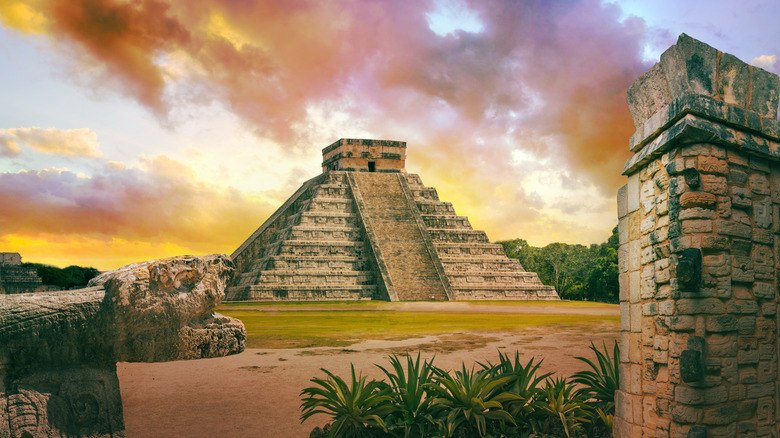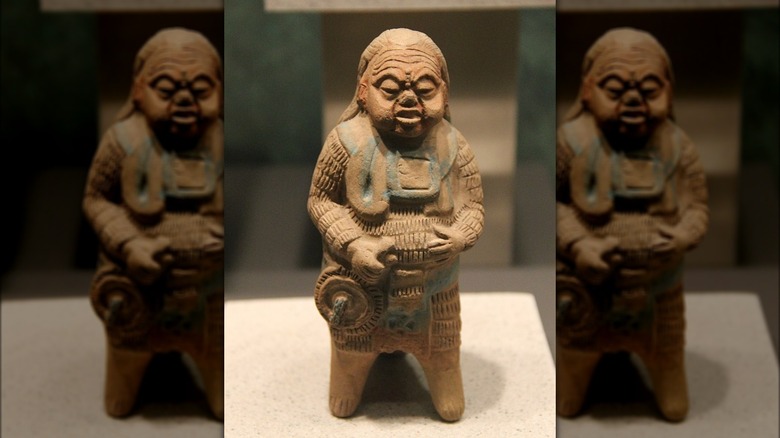What Is The Mythical, Mayan Creature Known As The Alux?
Mexican President Andrés Manuel López Obrador (AMLO) may have some interesting beliefs, at least based on a social media post the politician made in late February 2023. In a tweet, López Obrador posted a picture he claimed was an alux, a mythical creature rooted in traditional Mayan culture, similar to an elf or a goblin. In the photo, the glowing eyes and what might be the hair of the creature were captured in a purported night scene. AMLO's tweet, translated by Mexico News Daily, read, "I share two photos of our supervision of the Maya Train works: one, taken by an engineer three days ago, apparently of an aluxe [sic]; another, by Diego Prieto of a splendid pre-Hispanic sculpture in Ek Balam. Everything is mystical."
The Maya Train works AMLO referred to is reportedly the biggest infrastructure rail project in Mexican history, and it will cut through the Yucatán Peninsula, an otherwise economically underprivileged region of the country, where the Mayan culture once flourished in pre-Columbian Mesoamerica. The train project to bring economic prosperity caused controversy over the potential disruption and destruction of Mayan historical sites and artifacts. Some wondered whether the Mexican president was serious when sharing the alux photo (later revealed to have been taken many years before the president's post suggested), and the perceived contradiction of the Mexican politician referencing ancient Mayan culture while still supporting the Mayan rail project did not go unnoticed by some who commented.
They are reputedly mischievous creatures
Whether or not Andrés Manuel López Obrador believes in alux is uncertain, but if he was aware of one crucial part of the alux mythology, he might have thought twice about posting the photo (above). As Mexico News Daily explained, alux — appearing to sit high up on a tree branch in the photo the Mexican president shared — live in the forests and jungles and are said to dress as humans. The height of the Mayan civilization came between A.D. 300 A.D. and A.D. 900, at which time the once flourishing Mayan culture all but died out. Many Mayan descendants and other aspects of Mayan culture remain in the Yucatán Peninsula area.
Alongside the photo of the purported alux in AMLO's tweet was a real archaeological carving of an alux from Mayan history. If not placated with offerings and reverences, especially around building projects in their territory, alux are said to cause trouble. If not treated properly, they can be vengeful and vexing. When approached with respect, alux are said to be friendly. For this reason, according to Yucatán Magazine, one person wrote in response to AMLO's post that the politician needed "to ask permission" from the alux before sharing the picture "and offer tobacco, wine, water, and honey, following the ritual of our ancestors and the culture of our original peoples." The true prevalence of alux belief throughout ancient Mayan culture is uncertain.
Alux might have caused trouble before
If Andrés Manuel López Obrador's sharing of a purported alux on social media causes more problems for the Mayan rail system, it won't be the first time in the modern era that crossing an alux is said to have wreaked havoc on a building project on the Yucatán Peninsula. Also noted by Yucatán Magazine, in 2010, Elton John built a stage for an outdoor concert in the area, but he did not seek alux approval before building the structure. For that reason, the outlet says, the stage collapsed, causing injuries. Similar to the leprechaun of the British isles, some speculate the story of the alux may have originated through early interaction between Mayan cultures and British explorers.
At the height of their powers, the Mayans had an advanced social structure, according to the MesoAmerican Research Center at the University of Southern California, Santa Barbara. Overpopulation and lack of resources are believed to have perhaps caused the decline and eventual collapse of the Mayan civilization around A.D. 900, but the real reasons the classical Mayan society abruptly fell may never be known. There's now renewed interest in reviving and preserving aspects of Mayan culture and traditional wisdom — including the alux — and the Mayan language is now taught in school. There are an estimated 8 million Mayan descendants alive today, many of whom still inhabit the Yucatán Peninsula, where AMLO mistakenly said the purported picture of an alux was taken.

